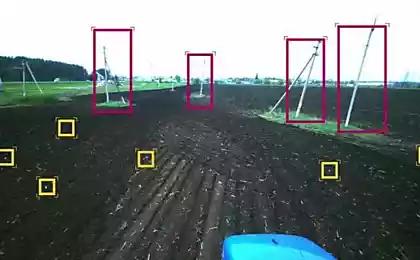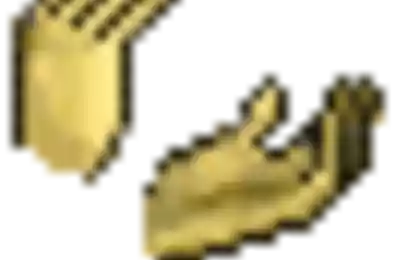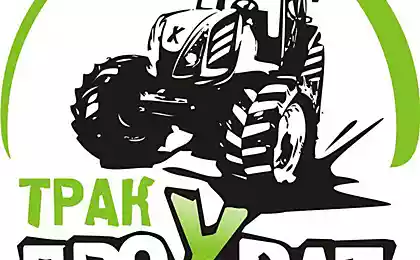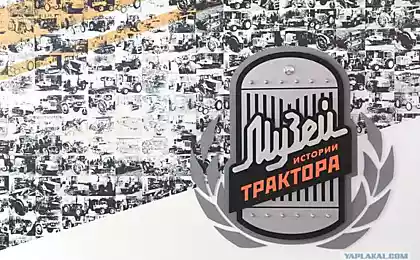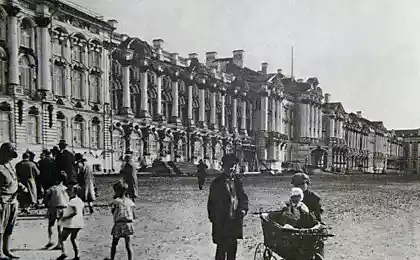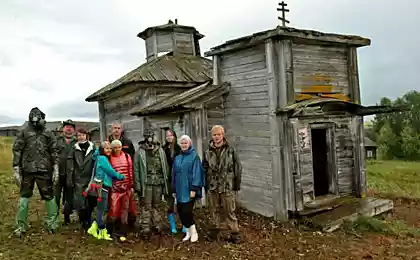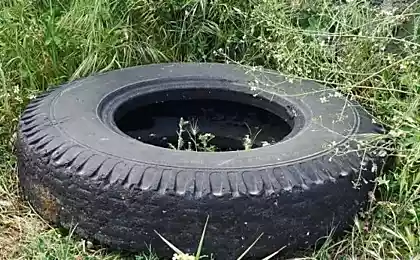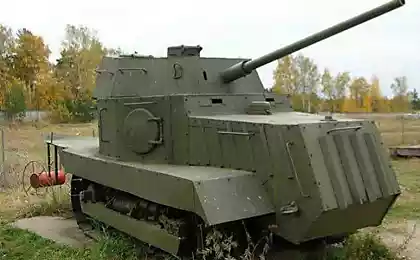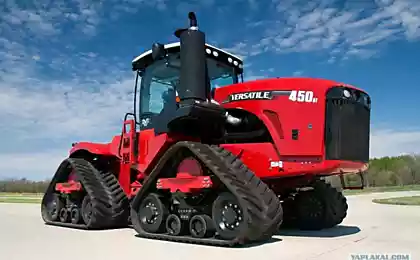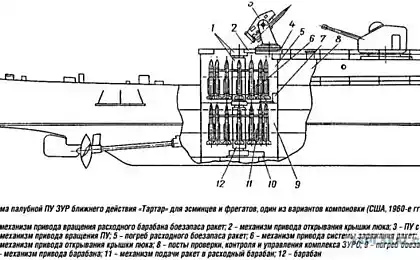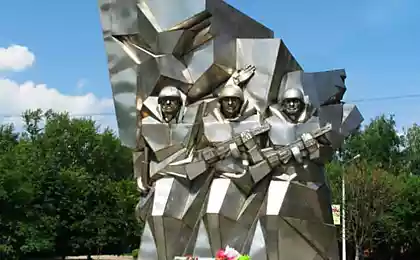1135
Artillery tractor
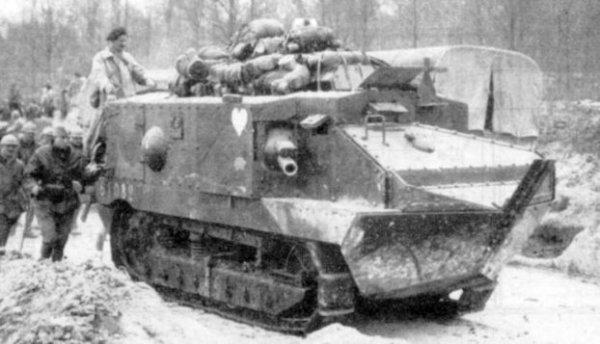
French themselves consider this machine the founder of his own tank-building, and, despite the many design flaws, according to the historians of this country during the campaign 1914 - 1918 g. tank "Schneider" distinguished himself as a "reliable and irreplaceable machine».
The idea of its creation is credited to General Etienne - the founder of the French armored forces that on the instructions of the General Staff on December 20, 1915, met with a representative of weapons of concern "Schneider - Le Creusot" Brihaye engineer and told him the concept of requirements for future combat vehicle. By December 22 the overall project was ready, and already 31 January 1916 was followed by an order for 400 of these machines.
French tanks (officially - "assault artillery tractor") bore little resemblance to its British counterparts. Pierre Letringez Lieutenant "special artillery", gave a clear and complete description of the tank in his book "Under the armor", an excerpt from which is reproduced below:
"Tank" Schneider "is a square blockhouse, its front end sticking out like a bow Korablin, bowsprit which is shaped like a horn, and the food is the double door, around which are located the fuel tanks (originally protected armored fuel tanks were located only in the the bow of the tank, but after the April fighting in 1916 to reduce the fire moved to the stern of the machine). The door on the left side led to a power plant; the roof was equipped with three hatches for the evacuation of the crew.
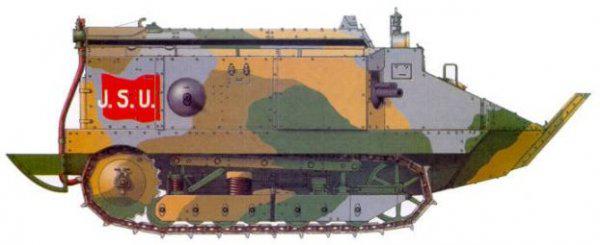
The length of the tank - 6 m, width - 2, 5 m, height 2 m 39, weight with equipment and ammunition 13, 5 tons.
Crew protection provided 11th m armor, reinforced at the front and side of the additional 8-mm sheet, which ensures complete protection from bullets and shrapnel. The driver was in the front right side of the bay, between the power plant and a gun; hinged flap and three peepholes allowed him to make a frontal observation. On either side are hinged hood, allowing the driver to get out of the tank through the roof.
Armament "Schneider" includes: 75-mm cannon shortened special design, the barrel is not more than 1 m, use a conventional 75-mm shell with a special charge, which is the initial velocity of flight - 200 m / s; the maximum effective range - 500 m, with long-range accuracy falls. This gun is located to the right of the driver, which is a tank commander and deputy commander of the fire kept the place which was behind. Ammunition shells - 90 pieces; the shells are loaded with the final calculation of the number at the moment in the bolt chambering.
In addition, there were two machine guns "Gochkiss", which were located in the ball mount on the sides of the tank; They are installed in such a way that fire nearly parallel to the axis of movement of the tank. Machine guns were directed by two arrows, one of which was also the mechanic responsible for the power plant, and the other - the shooter, conducting fire from both the gun and the right gun.
Thus, along with the crew of the tank commander included six people. The power plant of the tank - 4-cylinder engine of the company "Peugeot" or "Schneider", which rated power - 40 hp and 65 hp real Manual Transmission was carried out using a three-stage gearbox. Speed - 2 to 8 km / h. Caterpillar 3 m allowed to overcome obstacles up to a width of 1, 5 m in impassable terrain and areas 1, 7-1, 8 m with sufficient permeability. It should be noted that in 1915 these figures were considered normal. Naturally, in a spring thaw or after the aerial bombardment loose trench reached Z-4 m width, the tanks could not be overcome without additional work. We shall see later how this fact has determined a fundamental change in the tactics of warfare ».
This last remark is quite obvious Lestingeza characterizes the situation at the time the tank "Schneider" on the front. The first machine was ready to 8 September 1916, but the first division assault vehicles formed only in the beginning of December 1916 and by March 1917 the troops have already received 208 machines modification CA1 (char d`assaut assault tank 1). The experience of fighting with the May 5, 1917 tanks of this type speak from the front to modernize. It has been strengthened by imposing a reservation sides 5, 5 mm armor plates, as well as the bottom of the tank. Structural changes have also fuel tanks, which were originally located in front of the tank. They were transferred to the feed portion on both sides of the door, where the armor was thicker. Work on the modernization carried out in the park Shamlu, where, besides redevelopment placement of fuel tanks on tanks "Schneider" CA1 installed electric starter and interior lamps. Only in October 1917, these machines back to the front. Thus, there were two unofficial modification assault tank "Schneider" CA1: early and late.
Early modification can be visually distinguished on the ledges and a large double door in the rear of the machine. On the ledges strengthened with additional barrels of fuel that before the fight because of the increased fire hazard removed. In late modification ledges absent (were booked) - the volume occupied fuel tanks, and the door was Single and narrower.
At the beginning of 1917 by order of technical management of the army engineers have begun work on a version of the tank commander's CA2 with 47-mm gun turret and weighing 8 tons. However, the 100-hp engine, intended for it, it was not possible to start production, and on October 27 followed by an order to concentrate all efforts on the issue of tanks "Renault". Since the beginning of 1918 in the remaining parts of the CA1 began to withdraw and rework in the artillery tractors and transporters for transportation of various guns and tanks "Renault". A truce in the armed forces left 97 assault tanks "Schneider" CA1.
For the first time the French used their tanks in the course of April the Allied offensive on the Western Front (Operation Nivelle 1917) with the aim of a decisive defeat of the German armies. By the operation involved 132 machines of the "Schneider" CA1 under the command of Major bosses and Shobe.
Plan of attack April 16, 1917 at Shmende Dame for the first time provided for the use of combat assault tanks, natural forces existing 132 combat vehicles. They were divided into two groups, each of which was named in honor of his commander:
- A group of major boss in the 2, 4, 5, 6 and 9th battalions of tanks "Schneider»;
- Major Shobe group, consisting of 3, 7th and 8th divisions.
Each division consisted of 12 aircraft (three batteries of four tanks), support units, repair and several reserve tanks.
April 16 a group of Bossu had to attack the enemy in the direction between the rivers La Met and Leung in order to break through the second line of German defenses by Zhyuvenkur. Group Shobe, west of La Met, was to move towards Zhyuvenkur.
Group boss at the disposal of command 32 Corps had four divisions, acting on behalf of the 69th Division, and one division, which provides support for the 42nd Division. It was envisaged that the tanks would move, accompanied by infantry, specially trained for this purpose: five companies of the 154th Infantry Regiment. This is certainly an interesting tactical innovation. Tanks had to move to the second column of German troops abroad, as the passage of the first line of defense was to provide infantry support.
Alas, how great is the gap between theory and practice! The pace of advancement of combat vehicles was low even before reaching the first line of defense, because on the way of the tanks began to interfere with their convoys and infantry. Worse, when crossing the bridge over the river tanks La Met they were seen by observers of the German heavy artillery, and opened fire on them.
Thus, if a first-line of French defense went smoothly, then on the second turn of the situation changes radically when the front line of German defense: the French documents trench width is described as "stunning" because in some places it reaches 5 m. To ensure passage 154 th Infantry Regiment spent 45 minutes, during which the tanks were forced to spread out across the battlefield to avoid significant losses from artillery strikes.
Finally tanks began the promotion in 11 hours reached the second line of the German defense. The resistance was broken by the minor 151st Infantry Regiment, which was the size of the equipment is not sufficient for the area for the passage of tanks, so the crew had to dismount and carry out earthworks.
During the battle, Major Bossu died in a burning tank, which exploded from the shell hit the fuel tank.
Starting with the 12 hours of the day, coordination between tanks and infantry had been violated because the infantry were literally mark enemy fire. Thus, even without the support of tanks continued their advance to the third turn of the German defense. French losses were huge:
"The 9th Division Artillery special purpose crossed the second line of defense of the enemy to the north of the farm Mosham, then the column was moving in the direction of the trench Vyurtsbur. At this point, the fire of heavy artillery was unleashed on German tanks with unprecedented power and precision: four tanks, were moving back, knocked out for a few minutes; six advanced tanks one by one on fire in a short time. Crews, who managed to get out of combat vehicles, thrown into the trenches and try to continue the fight, but the German planes flying at extremely low altitudes, intersect them and shot at point blank range. Ordered to retreat ... ».
The report of the 3rd Division of the Supreme High Command summarizes the course of the battle of April 16: "The tanks are subjected to heavy artillery fire impact parameter bear substantial losses. However, several tanks of the central division crossed the third line of defense, and advanced more than 5 km in depth of the enemy defense. The infantry can not continue to advance due to significant losses ».
Of the 82 tanks "Schneider" group Bossu 32 were destroyed in the area of defense in the 12 defense lines of the French.
In the arrangement of the 10th Infantry Division's assault on the experience of fifty tanks Shobe group was even more sad because no tank "Schneider" could not overcome the first line of German defense, mainly because of the nature of the terrain, difficult to move tanks. 32 tanks were hit, 26 of them struck by artillery fire and burned.
Despite this double defeat, the French General Staff did not give up the use of tanks on the battlefield. In this there is considerable merit multiple machines from a group of major bosses who "in splendid isolation marched five kilometers deep into the German defense».
After the April attack, during 1917 tanks were used in the fighting only twice - 5 May and 23 October.
May 5 in the area of the mill Laffitte 19 tanks of the 1st and 10th Divisions went into battle with 12 tanks "Saint-Chamond." Total killed six tanks, and, according to French documents, "the operation is part of a success." However, the tanks "Schneider" shown during the battle his sizeable advantage over tanks "Saint-Chamond" which practically could not move in rough terrain.
From 23 to 25 October 38 tanks "Schneider" 12, 8th and 11th battalions of special purpose artillery were thrown into battle during the battle of La Malmaison, which were also used 20 tanks "Saint-Chamond»:
"The operation was carefully prepared. The attacking infantry units arrived to the landfill Shamlu for combat operations in conjunction with the tanks. Separate divisions fully coped with the task. Complete success. For the first time used the tanks to the radio transmitting stations ».
Combat the use of tanks in 1918, initially conducted without careful preparation: we are talking about the defensive measures undertaken to stop the German advance during the spring offensive of the German army.
April 5, 1918 g, in a place Soviler five tanks "Schneider" were thrown into a counterattack to support two infantry battalions in the direction of the farm Adelpar. Two tanks were destroyed in the "minor surgery, prepared in haste without taking into account the specifics of the special-purpose artillery. Difficult terrain conditions. Too broad front. The lack of success ».
April 7 with the same area of La Somme, this time in UAH, six tanks "Schneider" 2nd battalion counterattack support company 355 Infantry Regiment. As a result of the battle destroyed four cars: "The operation carried out in violation of the principles of the use of artillery, special forces. The results are mediocre, despite the courage of the crews of tanks ».
April 18 in the woods Seneca 12 tanks "Schneider" 3rd Battalion used in combat to support the 262 th Infantry Regiment: "The operation carried out in the shortest possible time. Well organized and carried out, the infantry tanks cleared a passage in the forest and Seneca Gros ETR. Padded 3 cars ».
28 May 12 tanks "Schneider" 5th Artillery Battalion for special purposes have been involved in the action in the interests of the 1st Division of the USA during the storming of the village cantina near Montdidier; This is the first major battle of the American division during the First World War. The results are more than positive: "Tanks cope with the tasks together with the infantry, which works with dedication and skill. Operation carefully prepared. Similar operations were carried out earlier. Complete success ».
The next time the tanks "Schneider" (56 cars) were used only 11 June 1918 in the Battle of Le Mas with 103 tanks, "Saint-Chamond».
Such a large number of military vehicles were used for the first time in the history of the French army. But the losses were considerable, because of the 56 tanks "Schneider" were destroyed or thrown 31 machine, and also lost 42 tanks "Saint-Chamond." Division Two tanks "Schneider" surrounded by Mary, then third division, together with Infantry Division joined the battle, but it soon dissipated tanks under fire of German artillery. Thus, we can say that the success was small, but the important thing is that the German offensive on the PC bogged down.
June 13, 1918 to have private surgery in the forest of Le Merle involving four tanks, but in the next month (July 9) The port on the farm was made a major assault on machines with 16 "Schneider" 16th and 17th battalions of special artillery purpose: "The sudden attack after a short artillery barrage. Tanks in an hour "B" begin to speak in front of the infantry and carry out the task. Fierce attack, carried out with minor losses.
From 18 to 24 July 1918 have been successfully used at least 226 light and medium tanks during the counteroffensive between Soissons and Chateau-Thierry. However, the loss can be considered huge: on the first day destroyed 58 vehicles, the second - 50, for the third - and fourth 17 - lost 21 tanks ».
July 23 remaining units re-enter the battle, which can be described as very serious. These objectives have not been met.
Once again on the battlefield, "Schneider" will appear only in August, the 17th and the 20th number in the Somme, near the Namsel. The number of cars entered slightly - from 12 to 28, but achieved good results.
12th and 13th September 1918 using 33 tanks "Schneider" from the 14th and 17th battalions to support the US attack on the entrance of Saint-Miyel. Operation performed brilliantly, only destroyed one tank, troops captured Essey and Mezro.
26 September 24 tanks "Schneider" from the same division conducted an attack in conjunction with the 35th US division, the results are considered to be mediocre: the promotion is carried out difficult and slow. The next day, the prevailing situation is almost identical to the previous one: even if the tanks reach the targets set, the infantry behind them barely keep up.
Since the end of September, the average tank-type "Schneider" is used less and less, they are replaced by light tanks "Renault". In the fierce battles between September 27-30 and Al Vel has been used several dozen tanks, "Schneider," but then they were assigned to the rear; then gradually decommissioned.
In addition to the French army; assault guns "Schneider" have also been used in other armies of the world.
In 1917, Italy, fought on the side of the Allies, tried to purchase 20 machines in France, "Schneider" and 100 light tanks «Renault» FT-17. However, due to the fact that by this time the issue of "Schneider" was discontinued, and the "Reno" were urgently needed by the French, Italy managed to send a "Schneider" and three "Renault» FT -17. Try them out, the Italians created a heavy tank "Fiat 2000" and easy "Fiat 3000" (model 1921), which, however, in the hostilities of World War I did not participate.
A source
